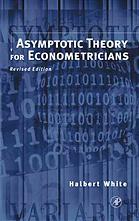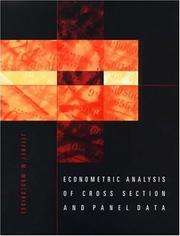| Listing 1 - 4 of 4 |
Sort by
|
Book
ISBN: 0262731835 9780262731836 Year: 2007 Publisher: Cambridge (Mass.) ; London : MIT,
Abstract | Keywords | Export | Availability | Bookmark
 Loading...
Loading...Choose an application
- Reference Manager
- EndNote
- RefWorks (Direct export to RefWorks)
The second edition of this acclaimed graduate text provides a unified treatment of two methods used in contemporary econometric research, cross section and data panel methods. By focusing on assumptions that can be given behavioral content, the book maintains an appropriate level of rigor while emphasizing intuitive thinking. The analysis covers both linear and nonlinear models, including models with dynamics and/or individual heterogeneity. In addition to general estimation frameworks (particular methods of moments and maximum likelihood), specific linear and nonlinear methods are covered in detail, including probit and logit models and their multivariate, Tobit models, models for count data, censored and missing data schemes, causal (or treatment) effects, and duration analysis.Econometric Analysis of Cross Section and Panel Data was the first graduate econometrics text to focus on microeconomic data structures, allowing assumptions to be separated into population and sampling assumptions. This second edition has been substantially updated and revised. Improvements include a broader class of models for missing data problems; more detailed treatment of cluster problems, an important topic for empirical researchers; expanded discussion of "generalized instrumental variables" (GIV) estimation; new coverage (based on the author's own recent research) of inverse probability weighting; a more complete framework for estimating treatment effects with panel data, and a firmly established link between econometric approaches to nonlinear panel data and the "generalized estimating equation" literature popular in statistics and other fields. New attention is given to explaining when particular econometric methods can be applied; the goal is not only to tell readers what does work, but why certain "obvious" procedures do not. The numerous included exercises, both theoretical and computer-based, allow the reader to extend methods covered in the text and discover new insights.
Econometrics --- Asymptotic theory --- Econometrics - Asymptotic theory
Book
ISBN: 0127466509 1322472890 1483294420 9780127466507 Year: 1984 Publisher: New York, NY : Academic Press,
Abstract | Keywords | Export | Availability | Bookmark
 Loading...
Loading...Choose an application
- Reference Manager
- EndNote
- RefWorks (Direct export to RefWorks)
This book is intended to provide a somewhat more comprehensive and unified treatment of large sample theory than has been available previously and to relate the fundamental tools of asymptotic theory directly to many of the estimators of interest to econometricians. In addition, because economic data are generated in a variety of different contexts (time series, cross sections, time series--cross sections), we pay particular attention to the similarities and differences in the techniques appropriate to each of these contexts.
Quantitative methods (economics) --- Econometrics --- Econométrie --- Asymptotic theory --- Théorie asymptotique --- Econométrie --- Théorie asymptotique --- Econometrics - Asymptotic theory --- Asymptotic theory.

ISBN: 0127466525 9780127466521 Year: 2001 Publisher: San Diego (Calif.): Academic press
Abstract | Keywords | Export | Availability | Bookmark
 Loading...
Loading...Choose an application
- Reference Manager
- EndNote
- RefWorks (Direct export to RefWorks)
Econometrics --- Asymptotic theory --- 330.115 --- -Economics, Mathematical --- Statistics --- Econometrie --- 330.115 Econometrie --- -Econometrie --- -330.115 Econometrie --- Economics, Mathematical --- Asymptotic theory in econometrics --- Asymptotic expansions --- Econometrics - Asymptotic theory

ISBN: 0262232197 0262232332 9780262232197 9780262232333 Year: 2002 Publisher: Cambridge (MA) London : M.I.T. Press,
Abstract | Keywords | Export | Availability | Bookmark
 Loading...
Loading...Choose an application
- Reference Manager
- EndNote
- RefWorks (Direct export to RefWorks)
The second edition of this acclaimed graduate text provides a unified treatment of two methods used in contemporary econometric research, cross section and data panel methods. By focusing on assumptions that can be given behavioral content, the book maintains an appropriate level of rigor while emphasizing intuitive thinking. The analysis covers both linear and nonlinear models, including models with dynamics and/or individual heterogeneity. In addition to general estimation frameworks (particular methods of moments and maximum likelihood), specific linear and nonlinear methods are covered in detail, including probit and logit models and their multivariate, Tobit models, models for count data, censored and missing data schemes, causal (or treatment) effects, and duration analysis.Econometric Analysis of Cross Section and Panel Data was the first graduate econometrics text to focus on microeconomic data structures, allowing assumptions to be separated into population and sampling assumptions. This second edition has been substantially updated and revised. Improvements include a broader class of models for missing data problems; more detailed treatment of cluster problems, an important topic for empirical researchers; expanded discussion of "generalized instrumental variables" (GIV) estimation; new coverage (based on the author's own recent research) of inverse probability weighting; a more complete framework for estimating treatment effects with panel data, and a firmly established link between econometric approaches to nonlinear panel data and the "generalized estimating equation" literature popular in statistics and other fields. New attention is given to explaining when particular econometric methods can be applied; the goal is not only to tell readers what does work, but why certain "obvious" procedures do not. The numerous included exercises, both theoretical and computer-based, allow the reader to extend methods covered in the text and discover new insights.
Econometrics --- Econométrie --- Asymptotic theory. --- Théorie asymptotique --- -Economics, Mathematical --- -Econometrie --- 330.015195 --- 330.115 --- 519.2 --- 303.5 --- AA / International- internationaal --- 330.115 Econometrie --- Econometrie --- Asymptotic theory in econometrics --- Asymptotic expansions --- Asymptotic theory --- Kwantitatieve methoden (economie) --- Wiskundige statistiek --- Theorie van correlatie en regressie. (OLS, adjusted LS, weighted LS, restricted LS, GLS, SLS, LIML, FIML, maximum likelihood). Parametric and non-parametric methods and theory (wiskundige statistiek) --- Mathematical statistics --- Quantitative methods (economics) --- Économétrie --- Econometrics - Asymptotic theory --- Acqui 2006 --- Économétrie --- ECONOMETRICS --- PANEL DATA --- ASYMPTOTIC THEORY
| Listing 1 - 4 of 4 |
Sort by
|

 Search
Search Feedback
Feedback About UniCat
About UniCat  Help
Help News
News